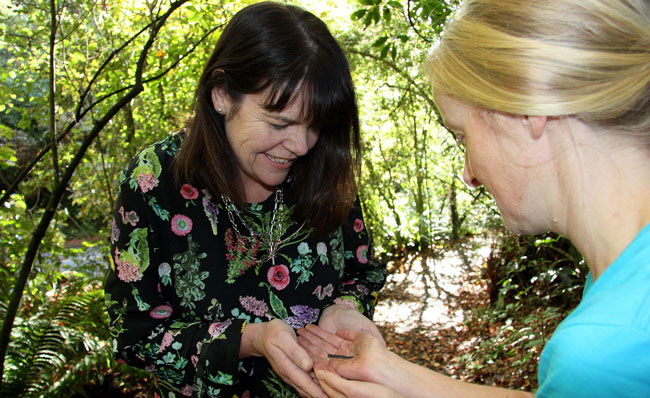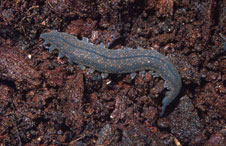 Tuesday 15 May 2018 11:08am
Tuesday 15 May 2018 11:08am
St Francis Xavier School Principal Carmel Jolly and Catchments Otago Project Leader Dr Cynthia Winkworth.

Peripatus (Velvet Worm). Photo: University of Otago Department of Zoology.
Researchers from Catchments Otago – a University of Otago Research Theme – are embarking on a year-long study with three Dunedin primary schools into the mysterious ancient velvet worm – peripatus – thanks to a $20,000 grant from the from the Ministry for Business Innovation and Employment's Participatory Science Platform (PSP).
Sounding like a villain in a child's fantasy (or perhaps horror) story, peripatus emerges at night and shoots its insect prey with poisonous spit before devouring them. In 2011 the Dunedin peripatus – labelled vulnerable by the International Union for Conservation of Nature – brought the Caversham motorway development to a grinding halt, as the worm's known habitat stood in the proposed roadway's path.
A subsequent study assessing peripatus habitats across different urban landscapes identified key factors for assisting conservation efforts. However, Dr Cynthia Winkworth from Catchments Otago says questions still need to be answered regarding how widespread are peripatus across Dunedin, and do habitats best for peripatus also show the highest invertebrate biodiversity.
“For conservation efforts to be successful, you need to have good baseline information about your organism, like where it lives and why it chooses to live there. What factors make one habitat more desirable over another?” says Dr Winkworth.
Primary students from Green Island, St Francis Xavier and Abbotsford Schools will assess urban Dunedin greenspaces for key peripatus habitat factors and overall invertebrate biodiversity, and compare these sites to their own school grounds. Working with the scientists from Catchments Otago (University of Otago) and the Otago Museum, the children will identify habitat features Dunedin peripatus prefer that also show the highest invertebrate biodiversity. The children will work to create such habitats on their school grounds and also produce flyers using their results to show others how to create peripatus-friendly habitats at home.
“This is a fantastic opportunity for some of our children to roll up their sleeves and get involved in some real science. This is a win-win as we will be helping to preserve the peripatus in our city, and pupils will be gaining real-world scientific experiences and knowledge,” Steve Hayward, Green Island Principal, says.
For further information, contact:
Dr Cynthia Winkworth
Associate Research Fellow
Catchments Otago
University of Otago
Email cynthia.winkworth@otago.ac.nz
Mark Hathaway
Senior Communications Adviser
University of Otago
Mob 021 279 5016
Email mark.hathaway@otago.ac.nz
A list of Otago experts available for media comment is available elsewhere on this website.
Electronic addresses (including email accounts, instant messaging services, or telephone accounts) published on this page are for the sole purpose of contact with the individuals concerned, in their capacity as officers, employees or students of the University of Otago, or their respective organisation. Publication of any such electronic address is not to be taken as consent to receive unsolicited commercial electronic messages by the address holder.
